Unit 10 Connections Lesson 1 Reading 课件(共24张,内嵌视频) 2024-2025学年高二英语北师版(2019)选择性必修4
文档属性
| 名称 | Unit 10 Connections Lesson 1 Reading 课件(共24张,内嵌视频) 2024-2025学年高二英语北师版(2019)选择性必修4 | 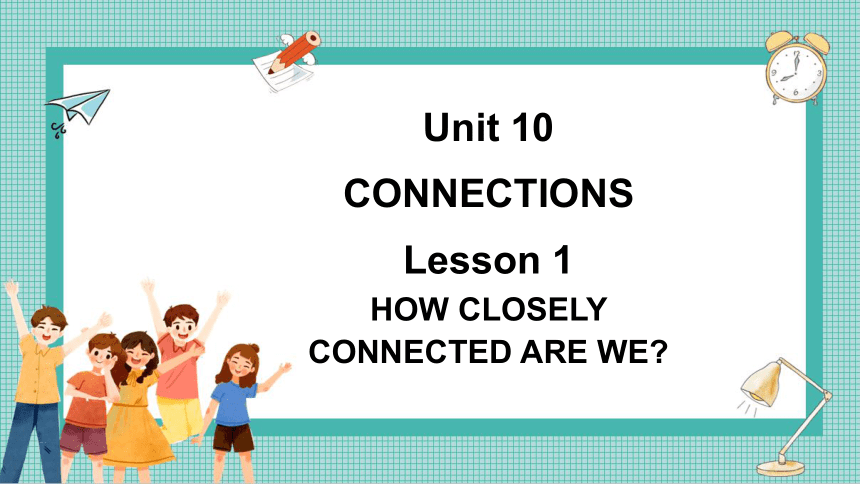 | |
| 格式 | pptx | ||
| 文件大小 | 6.3MB | ||
| 资源类型 | 教案 | ||
| 版本资源 | 北师大版(2019) | ||
| 科目 | 英语 | ||
| 更新时间 | 2025-04-28 15:31:08 | ||
图片预览


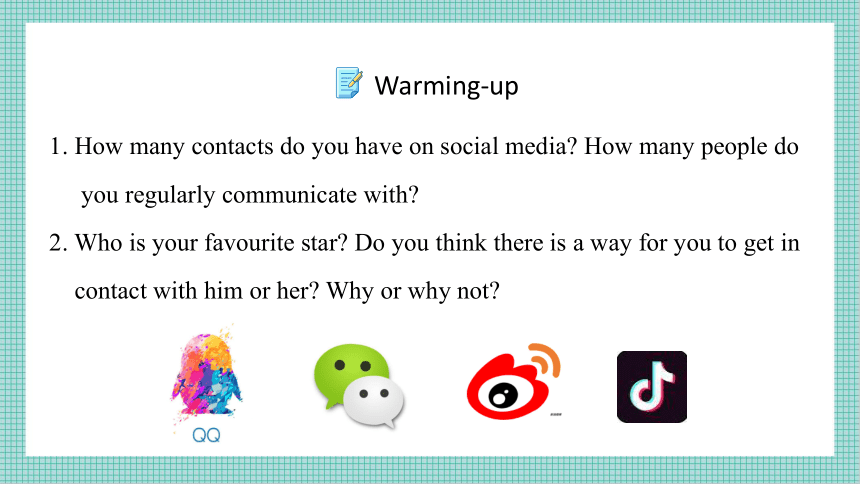
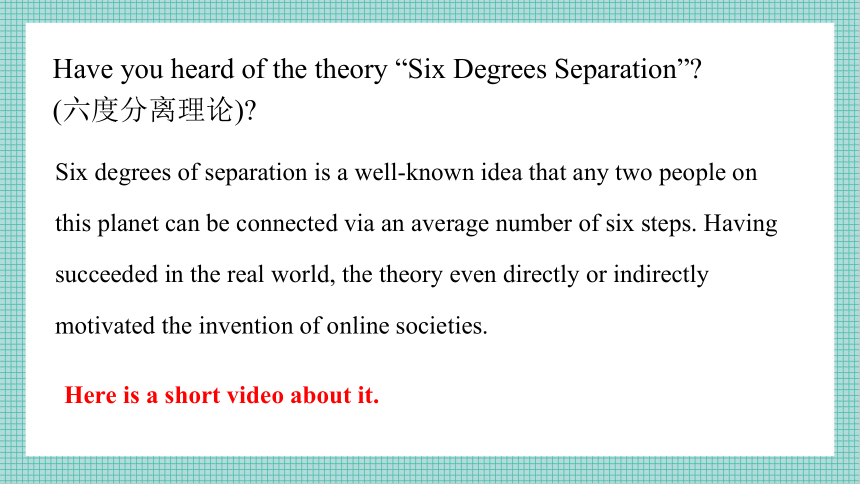


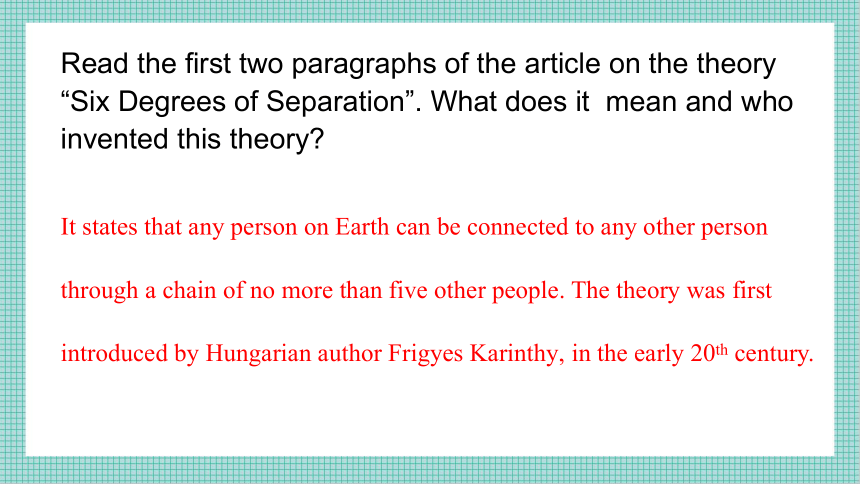
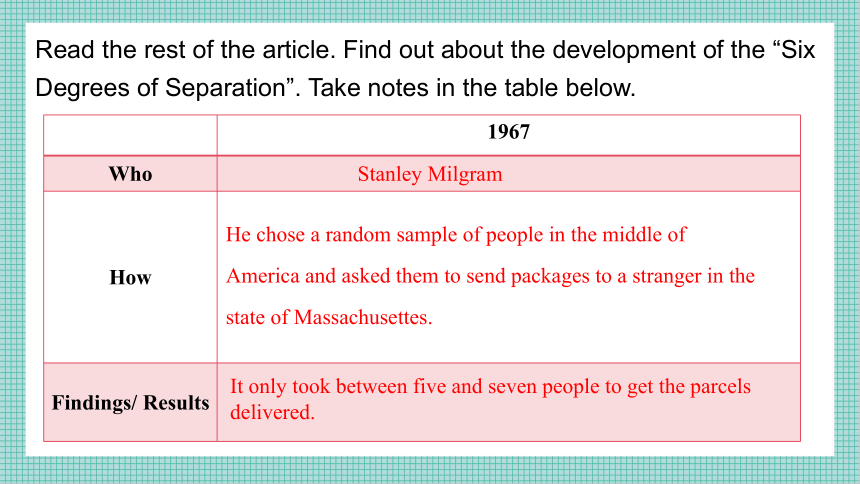
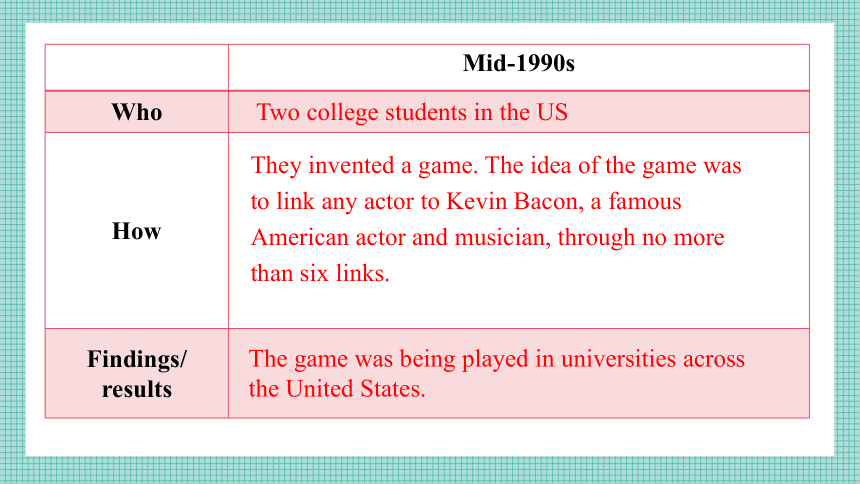
文档简介
(共24张PPT)
Unit 10
CONNECTIONS
Lesson 1
HOW CLOSELY CONNECTED ARE WE
1.To read and talk about the “Six Degrees of Separation” theory.
2.To read for deep understanding.
3.To read for specific information and make inferences.
4.To write a report.
Learning objectives
1. How many contacts do you have on social media How many people do you regularly communicate with
2. Who is your favourite star Do you think there is a way for you to get in contact with him or her Why or why not
Warming-up
Have you heard of the theory “Six Degrees Separation”
(六度分离理论)
Six degrees of separation is a well-known idea that any two people on this planet can be connected via an average number of six steps. Having succeeded in the real world, the theory even directly or indirectly motivated the invention of online societies.
Here is a short video about it.
Read the article quickly and find out the main idea.
This article introduces what the theory of “Six Degrees of Separation” is and how it develops.
Read the first two paragraphs of the article on the theory “Six Degrees of Separation”. What does it mean and who invented this theory
It states that any person on Earth can be connected to any other person through a chain of no more than five other people. The theory was first introduced by Hungarian author Frigyes Karinthy, in the early 20th century.
Read the rest of the article. Find out about the development of the “Six Degrees of Separation”. Take notes in the table below.
1967
Who
How
Findings/ Results
Stanley Milgram
He chose a random sample of people in the middle of America and asked them to send packages to a stranger in the state of Massachusettes.
It only took between five and seven people to get the parcels delivered.
Mid-1990s
Who
How
Findings/ results
Two college students in the US
They invented a game. The idea of the game was to link any actor to Kevin Bacon, a famous American actor and musician, through no more than six links.
The game was being played in universities across the United States.
2001
Who
How
Findings/ results
Columbia University
“Columbia Small-world Project”: Columbia University tried to recreate Milgram’s experiment on the Internet. The experiment involved 24,163 email chains with 18 target people in 13 different countries.
The results confirmed that the average number of links in the chain was six.
2011
Who
How
Findings/ results
the University of Milan
The experiment analysed the relationship between 721 million social media users.
92% were connected by only four stages.
Talk about how the theory developed based on your notes.
The concept was first talked.
The Hungarian author Frigyes Karinthy in the 1920s:
Publishing a book called Everything Is Different in 1929
Introducing the idea of __________ networks
His ideas influenced many of our early impressions of social networks.
Fill in the following blanks and find out how the author organises the article.
The American sociologist Stanley Milgram in 1967:
Trying a method called the “ ________________” to test the theory
His experiment’s results were published in Psychology Today.
His research ____________ the phrase “Six Degrees of Separation”.
friendship
small-world problem
inspired
Two American college students in the mid-1990s:
Inventing a game to link any __________ to Kevin Bacon through no more than six links
An experiment at the University of Milan in 2011:
Analysing the relationship between 721 million __________ users and finding that 92% were connected by only __________ stages
Columbia University in 2001:
Trying to __________ Milgram's experiment on the Internet
The “Columbia Small-world Project” confirmed that the average number of links in the chain was __________.
actor
recreate
six
social media
four
Find out how the author organises the passage.
作者采用时间顺序来向读者介绍了著名的“六度分隔”理论的发展史。时间顺序是常见的记叙顺序之一,可分为顺叙、插叙、倒叙。顺叙指的是按照事件的发展顺序进行叙述,先发生的事先叙述,后发生的事后叙述。本一文的作者就采用了顺叙的手法来向读者介绍著名理论“六度分隔”的发展史。
时间顺序主要通过正确运用时态以及时间状语、时间名词或小句形成的衔接来体现。本文作者在介绍“六度分隔”理论的发展史时,使用了大量表示时间的短语,如in the 1920s、in 1929、In the 1950s、after twenty years、In 1967、In the last few decades、In the mid-1990s、In 2001、in 2011等。在各个时间节点内,作者对“六度分隔”理论发展的细节进行了详尽的描述,并对相关实验过程进行了细致的描写,同时还通过举例子的方式向读者展示了这一理论的影响,以期读者能对该理论有一个全面的了解。
Read the article again. Take turns to explain the “Six Degrees of Separation” theory. Use the diagram to help you.
“Six Degrees of Separation”
What does it mean
When did the term first appear
What happened in the 1950s
What did Stanley Milgram do
How many people did it take for the parcel to reach the right person in Milgram’s experiment
How did it influence the entertainment industry
What is the “Columbia Small-world Project”
What was the result of the University of Milan’s research
Decide whether the following statements are true (T) or false (F).
1. Kevin Bacon is a famous Hungarian actor and musician. ( )
2. Stanley Milgram tried to prove the “Six Degrees of Separation” mathematically. ( )
3. Stanley Milgram found a sample of people who he had known before the experiment. ( )
4. Nearly all the survivors of the plane crash in Lost had come across each other or met someone the other survivors knew. ( )
Why does the writer ask the question “How might you be connected to the driver of the bus you regularly take or the person who delivers your parcels ” in the last paragraph
A. To help readers recall the development of “Six Degrees of Separation”.
B. To make readers relate themselves to the theory of “Six Degrees of Separation”.
C. To persuade readers to agree with his / her opinions on “Six Degrees of Separation”
1 Why did Milgram and Columbia University both label their experiments “Small world”
Because they believed that any person on Earth could be connected to any other person through a chain of no more than five other person. In this sense the world is small.
2 Why do you think people study how people are connected
Probably people want to study the structures of human society, the rules of human social activities, and how people are connected with each other.
Complete the sentences with the correct form of the words.
1. In 1967, a __________ called Stanley Milgram did an experiment to find out how many degrees of separation there were between strangers in different parts of American.
2. All of the _________ in Milgram’s experiment were delivered to the right people after passing through the hands of between five and seven people.
packages
sociologist
random sociologist network publish package chain
3. The results of Milgram’s experiment _____________ in the magazine Psychology Today.
4. The results of the “Columbia Small-world Project” confirmed that the average number of links in the ___________ was six.
5. People doing experiments into “Six Degrees of Separation” usually choose a ___________ sample of people to take part to make the results more reliable.
6. Recently, creating and growing your social ____________ has become more important than ever before due to the growth of social media.
chain
were published
random
network
random sociologist network publish package chain
Discuss and decide what experiment you can carry out to find out how many degrees of separation there are between people who don’t know each other. Consider:
how many people will participate in the experiment
what will the participants do
how will you find out the results of the experiment
Search online and find details about the “small-world problem”, “Columbia Small-world Project” or other experiments related to the theory. Write a short report on your findings.
Homework
Unit 10
CONNECTIONS
Lesson 1
HOW CLOSELY CONNECTED ARE WE
1.To read and talk about the “Six Degrees of Separation” theory.
2.To read for deep understanding.
3.To read for specific information and make inferences.
4.To write a report.
Learning objectives
1. How many contacts do you have on social media How many people do you regularly communicate with
2. Who is your favourite star Do you think there is a way for you to get in contact with him or her Why or why not
Warming-up
Have you heard of the theory “Six Degrees Separation”
(六度分离理论)
Six degrees of separation is a well-known idea that any two people on this planet can be connected via an average number of six steps. Having succeeded in the real world, the theory even directly or indirectly motivated the invention of online societies.
Here is a short video about it.
Read the article quickly and find out the main idea.
This article introduces what the theory of “Six Degrees of Separation” is and how it develops.
Read the first two paragraphs of the article on the theory “Six Degrees of Separation”. What does it mean and who invented this theory
It states that any person on Earth can be connected to any other person through a chain of no more than five other people. The theory was first introduced by Hungarian author Frigyes Karinthy, in the early 20th century.
Read the rest of the article. Find out about the development of the “Six Degrees of Separation”. Take notes in the table below.
1967
Who
How
Findings/ Results
Stanley Milgram
He chose a random sample of people in the middle of America and asked them to send packages to a stranger in the state of Massachusettes.
It only took between five and seven people to get the parcels delivered.
Mid-1990s
Who
How
Findings/ results
Two college students in the US
They invented a game. The idea of the game was to link any actor to Kevin Bacon, a famous American actor and musician, through no more than six links.
The game was being played in universities across the United States.
2001
Who
How
Findings/ results
Columbia University
“Columbia Small-world Project”: Columbia University tried to recreate Milgram’s experiment on the Internet. The experiment involved 24,163 email chains with 18 target people in 13 different countries.
The results confirmed that the average number of links in the chain was six.
2011
Who
How
Findings/ results
the University of Milan
The experiment analysed the relationship between 721 million social media users.
92% were connected by only four stages.
Talk about how the theory developed based on your notes.
The concept was first talked.
The Hungarian author Frigyes Karinthy in the 1920s:
Publishing a book called Everything Is Different in 1929
Introducing the idea of __________ networks
His ideas influenced many of our early impressions of social networks.
Fill in the following blanks and find out how the author organises the article.
The American sociologist Stanley Milgram in 1967:
Trying a method called the “ ________________” to test the theory
His experiment’s results were published in Psychology Today.
His research ____________ the phrase “Six Degrees of Separation”.
friendship
small-world problem
inspired
Two American college students in the mid-1990s:
Inventing a game to link any __________ to Kevin Bacon through no more than six links
An experiment at the University of Milan in 2011:
Analysing the relationship between 721 million __________ users and finding that 92% were connected by only __________ stages
Columbia University in 2001:
Trying to __________ Milgram's experiment on the Internet
The “Columbia Small-world Project” confirmed that the average number of links in the chain was __________.
actor
recreate
six
social media
four
Find out how the author organises the passage.
作者采用时间顺序来向读者介绍了著名的“六度分隔”理论的发展史。时间顺序是常见的记叙顺序之一,可分为顺叙、插叙、倒叙。顺叙指的是按照事件的发展顺序进行叙述,先发生的事先叙述,后发生的事后叙述。本一文的作者就采用了顺叙的手法来向读者介绍著名理论“六度分隔”的发展史。
时间顺序主要通过正确运用时态以及时间状语、时间名词或小句形成的衔接来体现。本文作者在介绍“六度分隔”理论的发展史时,使用了大量表示时间的短语,如in the 1920s、in 1929、In the 1950s、after twenty years、In 1967、In the last few decades、In the mid-1990s、In 2001、in 2011等。在各个时间节点内,作者对“六度分隔”理论发展的细节进行了详尽的描述,并对相关实验过程进行了细致的描写,同时还通过举例子的方式向读者展示了这一理论的影响,以期读者能对该理论有一个全面的了解。
Read the article again. Take turns to explain the “Six Degrees of Separation” theory. Use the diagram to help you.
“Six Degrees of Separation”
What does it mean
When did the term first appear
What happened in the 1950s
What did Stanley Milgram do
How many people did it take for the parcel to reach the right person in Milgram’s experiment
How did it influence the entertainment industry
What is the “Columbia Small-world Project”
What was the result of the University of Milan’s research
Decide whether the following statements are true (T) or false (F).
1. Kevin Bacon is a famous Hungarian actor and musician. ( )
2. Stanley Milgram tried to prove the “Six Degrees of Separation” mathematically. ( )
3. Stanley Milgram found a sample of people who he had known before the experiment. ( )
4. Nearly all the survivors of the plane crash in Lost had come across each other or met someone the other survivors knew. ( )
Why does the writer ask the question “How might you be connected to the driver of the bus you regularly take or the person who delivers your parcels ” in the last paragraph
A. To help readers recall the development of “Six Degrees of Separation”.
B. To make readers relate themselves to the theory of “Six Degrees of Separation”.
C. To persuade readers to agree with his / her opinions on “Six Degrees of Separation”
1 Why did Milgram and Columbia University both label their experiments “Small world”
Because they believed that any person on Earth could be connected to any other person through a chain of no more than five other person. In this sense the world is small.
2 Why do you think people study how people are connected
Probably people want to study the structures of human society, the rules of human social activities, and how people are connected with each other.
Complete the sentences with the correct form of the words.
1. In 1967, a __________ called Stanley Milgram did an experiment to find out how many degrees of separation there were between strangers in different parts of American.
2. All of the _________ in Milgram’s experiment were delivered to the right people after passing through the hands of between five and seven people.
packages
sociologist
random sociologist network publish package chain
3. The results of Milgram’s experiment _____________ in the magazine Psychology Today.
4. The results of the “Columbia Small-world Project” confirmed that the average number of links in the ___________ was six.
5. People doing experiments into “Six Degrees of Separation” usually choose a ___________ sample of people to take part to make the results more reliable.
6. Recently, creating and growing your social ____________ has become more important than ever before due to the growth of social media.
chain
were published
random
network
random sociologist network publish package chain
Discuss and decide what experiment you can carry out to find out how many degrees of separation there are between people who don’t know each other. Consider:
how many people will participate in the experiment
what will the participants do
how will you find out the results of the experiment
Search online and find details about the “small-world problem”, “Columbia Small-world Project” or other experiments related to the theory. Write a short report on your findings.
Homework
同课章节目录
- Unit 10 Connections
- Lesson 1 How Closely Connected Are We?
- Lesson 2 Community Spirit
- Lesson 3 Anne of Green Gables
- Unit 11 Conflict And Compromise
- Lesson 1 Living In a Community
- Lesson 2 Dealing with Conflict
- Lesson 3 War Memories
- Unit 12 Innovation
- Lesson 1 Scientific Breakthroughs
- Lesson 2 Aha Moment
- Lesson 3 Stephen Hawking
